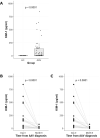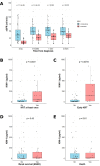Kidney injury molecule 1 (KIM-1): a potential biomarker of acute kidney injury and tubulointerstitial injury in patients with ANCA-glomerulonephritis
- PMID: 37664565
- PMCID: PMC10468750
- DOI: 10.1093/ckj/sfad071
Kidney injury molecule 1 (KIM-1): a potential biomarker of acute kidney injury and tubulointerstitial injury in patients with ANCA-glomerulonephritis
Abstract
Background: Kidney injury molecule 1 (KIM-1) is a transmembrane glycoprotein expressed by proximal tubular cells, recognized as an early, sensitive and specific urinary biomarker for kidney injury. Blood KIM-1 was recently associated with the severity of acute and chronic kidney damage but its value in antineutrophil cytoplasmic antibodies (ANCA)-associated vasculitis with glomerulonephritis (ANCA-GN) has not been studied. Thus, we analyzed its expression at ANCA-GN diagnosis and its relationship with clinical presentation, kidney histopathology and early outcomes.
Methods: We assessed KIM-1 levels and other pro-inflammatory molecules (C-reactive protein, interleukin-6, tumor necrosis factor α, monocyte chemoattractant protein-1 and pentraxin 3) at ANCA-GN diagnosis and after 6 months in patients included in the Maine-Anjou registry, which gathers data patients from four French Nephrology Centers diagnosed since January 2000.
Results: Blood KIM-1 levels were assessed in 54 patients. Levels were elevated at diagnosis and decreased after induction remission therapy. KIM-1 was associated with the severity of renal injury at diagnosis and the need for kidney replacement therapy. In opposition to other pro-inflammatory molecules, KIM-1 correlated with the amount of acute tubular necrosis and interstitial fibrosis/tubular atrophy (IF/TA) on kidney biopsy, but not with interstitial infiltrate or with glomerular involvement. In multivariable analysis, elevated KIM-1 predicted initial estimated glomerular filtration rate (β = -19, 95% CI -31, -7.6, P = .002).
Conclusion: KIM-1 appears as a potential biomarker for acute kidney injury and for tubulointerstitial injury in ANCA-GN. Whether KIM-1 is only a surrogate marker or is a key immune player in ANCA-GN pathogenesis remain to be determined.
Keywords: ANCA; KIM-1; glomerulonephritis; tubulointerstitial injury; vasculitis.
© The Author(s) 2023. Published by Oxford University Press on behalf of the ERA.
Conflict of interest statement
S.W. and G.B.P. are members of the CKJ editorial board. The other authors declare that they have no conflicts of interest in relation to this article.
Figures




References
LinkOut - more resources
Full Text Sources
Research Materials
Miscellaneous

